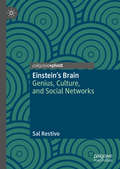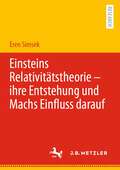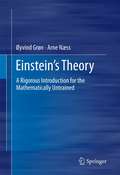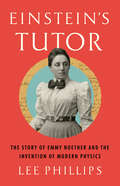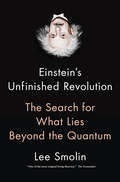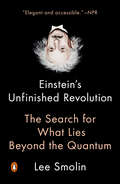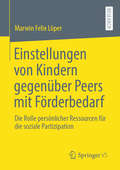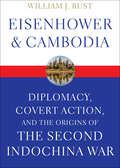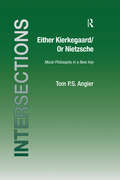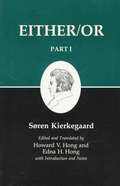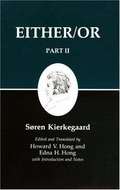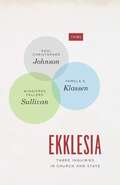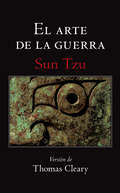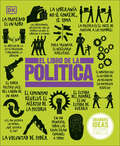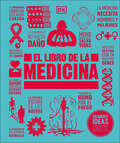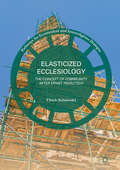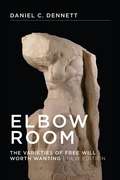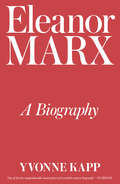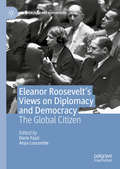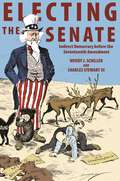- Table View
- List View
Einstein’s Brain: Genius, Culture, and Social Networks
by Sal RestivoThis book reviews the research on Einstein’s brain from a sociological perspective and in the context of the social brain paradigm. Instead of “Einstein, the genius of geniuses” standing on the shoulders of giants, Restivo proposes a concept of Einstein the social being standing on the shoulders of social networks. Rather than challenging Einstein’s uniqueness or the uniqueness of his achievements, the book grounds Einstein and his achievements in a social ecology opposed to the myths of the “I,” individualism, and the very idea of “genius.” “Einstein” is defined by the particular configuration of social networks that he engaged as his life unfolded, not by biological inheritances.
Einstein's Opponents
by Milena Wazeck Geoffrey S. KobyThis detailed account of the controversy surrounding the publication of Albert Einstein's theory of relativity explores the ferocious popular and academic opposition which at one time encircled one of the most important scientific breakthroughs of the twentieth century. Based on extensive archival research, this fascinating discourse includes a compelling and entertaining examination of the contemporary literature created by Einstein's detractors. Exploring the arguments and strategies, social contexts, and motivations of Einstein's detractors, and providing unique insights into the dynamics of scientific controversies, this book is ideal for anyone interested in the history and philosophy of physics, popular science, and the public understanding of science.
Einsteins Relativitätstheorie – ihre Entstehung und Machs Einfluss darauf
by Eren SimsekRoman U. Sexl schreibt in seinem Artikel „Der unerschöpfliche Albert Einstein“, dass „gerade rund um die Ursprünge der speziellen Relativitätstheorie einige wesentliche wissenschaftsgeschichtliche Fragen“ noch offen stehen und betont: „Eine der interessantesten Fragen betrifft die Quellen Einsteins.“ Von ihm kommt der wichtige Hinweis, sich Einsteins Kyoto-Rede bzw. die „, inoffizielle Nobelpreisrede‘“ näher anzusehen. Diese Rede, in welcher Einstein genau vor hundert Jahren die Entstehungsgeschichte der Relativitätstheorie erläutert, ist von größerem Interesse, weil Einstein darin oft auf Mach hinweist. Weder der historische Kontext der Rede wurde bis jetzt untersucht noch der Versuch unternommen, den Inhalt der Rede zu rekonstruieren. Betrachtet man den historischen Kontext, erweist sich dieser Vortrag nämlich zum Teil als Einsteins Reaktion auf das (gefälschte) Vorwort in Die Prinzipien der physikalischen Optik, worin E. Mach als Relativitätstheorie-Gegner dargestellt wurde. Einstein macht in seiner Rede darauf aufmerksam, welch wichtige erkenntnistheoretische Rolle Machs Arbeiten für ihn hatten. Aufgrund der neuen Ergebnisse in der Mach-Einstein-Forschung werden in dieser Arbeit daher die Entstehungsgeschichte der Relativitätstheorie sowie der Inhalt der Kyoto-Rede wissenschaftsgeschichtlich rekonstruiert und Machs Einfluss darauf genauer analysiert.
Einstein's Theory
by Øyvind Grøn Arne NæssThis book provides an introduction to the theory of relativity and the mathematics used in its processes. Three elements of the book make it stand apart from previously published books on the theory of relativity. First, the book starts at a lower mathematical level than standard books with tensor calculus of sufficient maturity to make it possible to give detailed calculations of relativistic predictions of practical experiments. Self-contained introductions are given, for example vector calculus, differential calculus and integrations. Second, in-between calculations have been included, making it possible for the non-technical reader to follow step-by-step calculations. Thirdly, the conceptual development is gradual and rigorous in order to provide the inexperienced reader with a philosophically satisfying understanding of the theory. The goal of this book is to provide the reader with a sound conceptual understanding of both the special and general theories of relativity, and gain an insight into how the mathematics of the theory can be utilized to calculate relativistic effects.
Einstein's Tutor: The Story of Emmy Noether and the Invention of Modern Physics
by Lee PhillipsA revelatory story of the woman who made foundational contributions to science and mathematics and persevered in the face of discrimination. Emmy Noether's mathematical genius enabled Einstein to bring his General Theory of Relativity–the basis of our current theory of gravity–to fruition. On a larger scale, what came to be known as &“Noether&’s Theorem&”—called by a Nobel laureate &“the single most profound result in all of physics&”—supplied the basis for the most accurate theory in the history of physics, the Standard Model, which forms our modern theory of matter. Noether&’s life story is equally important and revelatory in understanding the pernicious nature of sexual prejudice in the sciences, revealing the shocking discrimination against one of the true intellectual giants of the twentieth century, a woman effectively excluded from the opportunities given to her male counterparts. Noether&’s personality and optimistic spirit, as Lee Phillips reveals, enabled her unique genius to persevere and arrive at insights that still astonish those who encounter them a century later.
Einstein's Unfinished Revolution: The Search for What Lies Beyond the Quantum
by Lee SmolinA daring new vision of the quantum universe, and the scandals controversies, and questions that may illuminate our future--from Canada's leading mind on contemporary physics.Quantum physics is the golden child of modern science. It is the basis of our understanding of atoms, radiation, and so much else, from elementary particles and basic forces to the behaviour of materials. But for a century it has also been the problem child of science, plagued by intense disagreements between its intellectual giants, from Albert Einstein to Stephen Hawking, over the strange paradoxes and implications that seem like the stuff of fantasy. Whether it's Schrödinger's cat--a creature that is simultaneously dead and alive--or a belief that the world does not exist independently of our observations of it, quantum theory is what challenges our fundamental assumptions about our reality. In Einstein's Unfinished Revolution, globally renowned theoretical physicist Lee Smolin provocatively argues that the problems which have bedeviled quantum physics since its inception are unsolved for the simple reason that the theory is incomplete. There is more, waiting to be discovered. Our task--if we are to have simple answers to our simple questions about the universe we live in--must be to go beyond it to a description of the world on an atomic scale that makes sense. In this vibrant and accessible book, Smolin takes us on a journey through the basics of quantum physics, introducing the stories of the experiments and figures that have transformed the field, before wrestling with the puzzles and conundrums that they present. Along the way, he illuminates the existing theories about the quantum world that might solve these problems, guiding us toward his own vision that embraces common sense realism. If we are to have any hope of completing the revolution that Einstein began nearly a century ago, we must go beyond quantum mechanics as we know it to find a theory that will give us a complete description of nature. In Einstein's Unfinished Revolution, Lee Smolin brings us a step closer to resolving one of the greatest scientific controversies of our age.
Einstein's Unfinished Revolution: The Search for What Lies Beyond the Quantum
by Lee SmolinA daring new vision of quantum theory from one of the leading minds of contemporary physicsQuantum physics is the golden child of modern science. It is the basis of our understanding of atoms, radiation, and so much else, from elementary particles and basic forces to the behavior of materials. But for a century it has also been the problem child of science: it has been plagued by intense disagreements between its inventors, strange paradoxes, and implications that seem like the stuff of fantasy. Whether it's Schrödinger's cat--a creature that is simultaneously dead and alive--or a belief that the world does not exist independently of our observations of it, quantum theory challenges our fundamental assumptions about reality. In Einstein's Unfinished Revolution, theoretical physicist Lee Smolin provocatively argues that the problems which have bedeviled quantum physics since its inception are unsolved and unsolvable, for the simple reason that the theory is incomplete. There is more to quantum physics, waiting to be discovered. Our task--if we are to have simple answers to our simple questions about the universe we live in--must be to go beyond quantum mechanics to a description of the world on an atomic scale that makes sense. In this vibrant and accessible book, Smolin takes us on a journey through the basics of quantum physics, introducing the stories of the experiments and figures that have transformed our understanding of the universe, before wrestling with the puzzles and conundrums that the quantum world presents. Along the way, he illuminates the existing theories that might solve these problems, guiding us towards a vision of the quantum that embraces common sense realism. If we are to have any hope of completing the revolution that Einstein began nearly a century ago, we must go beyond quantum mechanics to find a theory that will give us a complete description of nature. In Einstein's Unfinished Revolution, Lee Smolin brings us a step closer to resolving one of the greatest scientific controversies of our age.
Einstellungen von Kindern gegenüber Peers mit Förderbedarf: Die Rolle persönlicher Ressourcen für die soziale Partizipation
by Marwin Felix LöperDie Einstellungen von Grundschulkindern gegenüber Peers mit Förderbedarf stellen eine wichtige Voraussetzung für die soziale Partizipation von Kindern mit emotional-sozialem Förderbedarf im inklusiven Grundschulunterricht dar. Vor diesem Hintergrund geht Marwin Felix Löper in diesem Buch der Frage nach, ob und inwiefern sich die Einstellungen von Grundschulkindern gegenüber Peers mit emotional-sozialem Förderbedarf durch ihre Empathie, ihren bisherigen Kontakt zu Menschen mit Förderbedarf und ihr soziales Selbstkonzept erklären lassen. Hierbei konnte er nachweisen, dass die Fürsorglichkeit – als Teil der Empathie – und der Kontakt zu Menschen mit Förderbedarf prädiktiv für die Einstellungen von Grundschulkindern zu Peers mit emotional-sozialem Förderbedarf sind.
Eisenhower & Cambodia: Diplomacy, Covert Action, and the Origins of the Second Indochina War (Studies In Conflict, Diplomacy, And Peace Ser.)
by William J. RustThis historical study examines America’s Cold War diplomacy and covert operations intended to lure Cambodia from neutrality to alliance.Although most Americans paid little attention to Cambodia during Dwight D. Eisenhower’s presidency, the global ideological struggle with the Soviet Union guaranteed US vigilance throughout Southeast Asia. Cambodia’s leader, Norodom Sihanouk, refused to take sides in the Cold War, a policy that disturbed US officials. From 1953 to 1961, his government avoided the political and military crises of neighboring Laos and South Vietnam. However, relations between Cambodia and the United States suffered a blow in 1959 when Sihanouk discovered CIA involvement in a plot to overthrow him. The failed coup only increased Sihanouk’s power and prestige, presenting new foreign policy challenges in the region.In Eisenhower and Cambodia, William J. Rust demonstrates that covert intervention in the political affairs of Cambodia proved to be a counterproductive tactic for advancing the United States’ anticommunist goals. Drawing on recently declassified sources, Rust skillfully traces the impact of “plausible deniability” on the formulation and execution of foreign policy. His meticulous study not only reveals a neglected chapter in Cold War history but also illuminates the intellectual and political origins of US strategy in Vietnam and the often-hidden influence of intelligence operations in foreign affairs.
Either Kierkegaard/Or Nietzsche: Moral Philosophy in a New Key (Intersections: Continental and Analytic Philosophy)
by Tom P.S. AngierArguably Søren Kierkegaard and Friedrich Nietzsche are the two most significant moral philosophers of the nineteenth century, their works showing a remarkably trenchant and penetrating awareness of key ethical issues, while demonstrating a stylistic flair that is rare in philosophical writing. Angier argues that, despite the perceived stylistic opacity of these thinkers, their work does admit of comparison and rigorous analytic scrutiny which in turn yields new and significant insights into their philosophy. In this book Angier expounds the view that Kierkegaard both anticipated, and subjected to detailed critique, Nietzsche's central arguments in moral philosophy, exposing the weaknesses of what were to become the core Nietzschean positions and realizing the powerful attraction for people that these ideas would have. Angier brings this critique to our modern attention and defends the prefigured Kierkegaardian critique of Nietzsche.
Either/Or: A Fragment of Life
by Soren KierkegaardIn Either/Or, using the voices of two characters - the aesthetic young man of part one, called simply 'A', and the ethical Judge Vilhelm of the second section - Kierkegaard reflects upon the search for a meaningful existence, contemplating subjects as diverse as Mozart, drama, boredom, and, in the famous Seducer's Diary, the cynical seduction and ultimate rejection of a young, beautiful woman. A masterpiece of duality, Either/Or is a brilliant exploration of the conflict between the aesthetic and the ethical - both meditating ironically and seductively upon Epicurean pleasures, and eloquently expounding the noble virtues of a morally upstanding life.
Either / Or, Part I
by Søren Kierkegaard Howard V. Hong Edna H. HongIn Either/Or, using the voices of two characters - the aesthetic young man of part one, called simply 'A', and the ethical Judge Vilhelm of the second section - Kierkegaard reflects upon the search for a meaningful existence, contemplating subjects as diverse as Mozart, drama, boredom, and, in the famous Seducer's Diary, the cynical seduction and ultimate rejection of a young, beautiful woman. A masterpiece of duality, Either/Or is a brilliant exploration of the conflict between the aesthetic and the ethical - both meditating ironically and seductively upon Epicurean pleasures, and eloquently expounding the noble virtues of a morally upstanding life.
Either / Or, Part II
by Edna H. Hong Howard V. Hong Søren KierkegaardIn Either/Or, using the voices of two characters - the aesthetic young man of part one, called simply 'A', and the ethical Judge Vilhelm of the second section - Kierkegaard reflects upon the search for a meaningful existence, contemplating subjects as diverse as Mozart, drama, boredom, and, in the famous Seducer's Diary, the cynical seduction and ultimate rejection of a young, beautiful woman.
Ejemplaridad pública (edición conmemorativa con prólogo del autor)
by Javier Gomá LanzónTaurus recupera Ejemplaridad pública, el libro de filosofía más emblemático de los últimos años, para conmemorar el décimo aniversario de su publicación. Este libro defiende la ejemplaridad, igualitaria y secularizada, como principio organizador de la democracia moderna en la convicción de que, en esta época postnihilista, en la que autoritarismo y coerción han perdido su poder cohesionador, solo la fuerza persuasiva del ejemplo virtuoso, generador de costumbres cívicas, es capaz de promover la auténtica emancipación del ciudadano. La crítica opina:«Un soplo de aire fresco. Sacude las sombras de las antiguas tradiciones con la claridad de un arroyo de montaña. Ofrece también una nueva visión, perspicaz y necesaria, de los futuros posibles. Insuflará nueva vida a nuestra perpetua búsqueda de sentido.»Zygmunt Bauman «De lejos el intelectual español más interesante y profundo del momento, una especie de hombre del Renacimiento.»Joseph Weiler «Uno de los intelectuales públicos más distinguidos de España. Una propuesta audaz y atractiva que contribuye a revitalizar la filosofía y enriquecer la vida cívica de las sociedades democráticas.»Michael Sandel «A veces pienso que una buena antología de los textos de Gomá o, por qué no, todos ellos, podrían figurar como adenda de la misma Constitución una vez que sea revisada.»César Antonio De Molina «Un fenómeno dentro del pensamiento español actual.»Javier Rodríguez Marcos, El País «Una de las obras mayores para quienes se toman en serio la crisis política actual, que es moral.»J.M. Ureña, El Periódico «El capítulo "La auténtica fuente de moralidad social" deberían ponerlo en las paradas del bus y del metro.»Luis Algorri, Tiempo «En este ambiente de cinismo generalizado no puede ser más oportuno este libro.»Germán Cano, La Razón «Admirable ensayo.»Félix de Azúa «Un éxito fulgurante.»Manuel Barrios, El Cultural «Como nos recuerda el brillante filósofo español Javier Gomá Lanzón, la educación moral se da mediante el poder del ejemplo.»David Brooks, The New York Time «Javier Gomá medita sobre un tiempo geológico -el filosófico- sin renunciar a observar urgencias del presente. Se apropia de conceptos caídos en desuso y los rellena con savia nueva.»Tereixa Constenla, El País «Un hombre cuya formación lo convierte en una espléndida rareza dentro del ámbito del nuevo pensamiento español.»ABC «Javier Gomá se ha convertido con todo merecimiento en una destacada figura del panorama intelectual español.»El Cultural «Un pensador en alza.»El Mundo «El filósofo Javier Gomá es el pensador de moda.»Babelia
Ekklesia: Three Inquiries in Church and State (TRIOS)
by Paul Christopher Johnson Pamela E. Klassen Winnifred Fallers SullivanEkklesia: Three Inquiries in Church and State offers a New World rejoinder to the largely Europe-centered academic discourse on church and state. In contrast to what is often assumed, in the Americas the relationship between church and state has not been one of freedom or separation but one of unstable and adaptable collusion. Ekklesia sees in the settler states of North and South America alternative patterns of conjoined religious and political power, patterns resulting from the undertow of other gods, other peoples, and other claims to sovereignty. These local challenges have led to a continuously contested attempt to realize a church-minded state, a state-minded church, and the systems that develop in their concert. The shifting borders of their separation and the episodic conjoining of church and state took new forms in both theory and practice. The first of a closely linked trio of essays is by Paul Johnson, and offers a new interpretation of the Brazilian community gathered at Canudos and its massacre in 1896–97, carried out as a joint churchstate mission and spectacle. In the second essay, Pamela Klassen argues that the colonial churchstate relationship of Canada came into being through local and national practices that emerged as Indigenous nations responded to and resisted becoming “possessions” of colonial British America. Finally, Winnifred Sullivan’s essay begins with reflection on the increased effort within the United States to ban Bibles and scriptural references from death penalty courtrooms and jury rooms; she follows with a consideration of the political theological pressure thereby placed on the jury that decides between life and death. Through these three inquiries, Ekklesia takes up the familiar topos of “church and state” in order to render it strange.
El arte de la guerra (Clásicos Ilustrados Ser. #Vol. 1)
by Sun Tzu Thomas ClearyRecopilado más de dos mil años atrás por un misterioso guerrero filósofo, El arte de la guerra sigue siendo, quizás, hoy en día, el libro de estrategia más prestigioso e influyente del mundo, estudiado en Asia por políticos modernos y ejecutivos con el mismo entusiasmo con el que fuera consultado en tiempos antiguos por jefes militares. Como estudio de la anatomía de las organizaciones en conflicto, El arte de la guerra se aplica en general a la competencia y al conflicto, en todo nivel, desde el interpersonal al internacional. Su objetivo es la invencibilidad, la victoria sin dar batalla, y la fuerza inexpugnable gracias a la comprensión de la física, la política y la psicología del conflicto. Compiled more than two thousand years ago by a mysterious warrior-philosopher, The Art of War is still perhaps the most prestigious and influential book of strategy in the world today, as eagerly studied in Asia by modern politicians and executives as it has been by military leaders since ancient times. As a study of the anatomy of organizations in conflict, The Art of War applies to competition and conflict in general, on every level from the interpersonal to the international. Its aim is invincibility, victory without battle, and unassailable strength through understanding of the physics, politics, and psychology of conflict.
El libro de la política (DK Big Ideas)
by DKGrandes ideas, explicaciones sencillasCon un lenguaje claro, El libro de la política ofrece concisas explicaciones que desbrozan la jerga académica, esquemas que hacen sencillas las teorías más complejas e ingeniosas ilustraciones que juegan con nuestra comprensión de la política.¿Debe ser derrocado un gobernante injusto? ¿Es la democracia la mejor forma de gobierno? ¿Puede ser justa una guerra? A lo largo de la historia, estas y otras preguntas acerca de cuál es el mejor modo de gobernarnos han suscitado respuestas de grandes pensadores que hoy siguen dando forma al mundo.La política explicada de forma sencilla¿Crees que la política exisitiría si todos pudie´ramos tener lo que queremos cuando lo queremos? Sea cual fuere el significado exacto de esa actividad compleja llamada poli´tica -y, como expone este libro, se ha entendido de muchas formas distintas-, esta´ claro que la experiencia humana nunca nos da todo lo que queremos.Hemos de competir, esforzarnos, pactar y, a veces, luchar por ello. Al hacerlo creamos un lenguaje para explicar y justificar nuestras demandas y para retar, contradecir o responder a las demandas de los dema´s. Este lenguaje podri´a ser, o bien un lenguaje de intereses, ya sean individuales o grupales, o bien de valores, como en el caso de los derechos y las libertades o de la igualdad y la justicia. Pero, desde sus inicios, lo primordial de la actividad poli´tica es la creacio´n de ideas y conceptos poli´ticos que nos ayuden a exigir y defender nuestros intereses.La defensa de intereses ha mutado a lo largo de los años y así lo ha hecho la ciencia de la política. Tanto el neófito como el estudiante o el experto aficionado encontrarán en este libro de política en español numerosos contenidos de su interés a través de los siguientes capítulos: • El pensamiento político en la antigüedad. 800 A.C.-30 D.C. • Política medieval. 30-515. • Racionalismo e ilustración. 1515-1770. • Ideas revolucionarias. 1770-1848. • La rebelión de las masas. 1848-1910. • Choque de ideologías. 1910-1945. • La política de posguerra. 1945-presente.El libro de la política, pertenece a la galardonada serie Grandes Ideas explica temas complejos de un modo fácil de entender mediante explicaciones claras y alejándose del academicismo tradicional. Su creativo diseño y los gráficos innovadores que acompañan al texto hacen de esta serie una introducción perfecta a una gran diversidad de materias para toda la familia.
El libro de las matemáticas (DK Big Ideas)
by DKGrandes ideas, explicaciones sencillasEscrito en un lenguaje accesible, El libro de las matemáticas presenta explicaciones claras y concisas que desbrozan la jerga especializada, diagramas que plasman complejas teorías, citas memorables e ingeniosas ilustraciones que juegan con nuestras ideas acerca de los números.¿Qué es un número imaginario? ¿Cómo pueden servir las matemáticas para predecir el futuro? A lo largo de la historia, los matemáticos se han planteado grandes preguntas como estas, y han proporcionado respuestas que ayudan a comprenderlo todo, desde los patrones de la naturaleza hasta la tecnología informática actual.Tanto el alumno motivado como quien simplemente sienta curiosidad por las matemáticas se sentirán intrigados y estimulados por muchas de las ideas de este libro.
Elastic Language
by Grace Q. ZhangElastic language carries non-specific and stretchable meaning, as in 'He loves her, kind of'. It is used like a slingshot, targeting various strategic goals. Consolidating current research and charting new directions, this book develops a refreshing theory of elasticity, empirically attested by natural language data from tension-prone encounters between Australian Customs officers and passengers. The theory proposes three principles (fluidity, stretchability and strategy) and offers a systematic look at how elastic language, as a sliding scale, works to balance strengthening and weakening speech tones, to firm and soften a speaker's stance, and to reveal and evade the truth. The comparative analysis of forms, functions, and context confirms that elastic language is fluid, stretchable, and strategic. It serves both cooperative and competitive functions, and social and speech factors impact on its use. This book will appeal to students and researchers working in pragmatics, applied linguistics, sociolinguistics, discourse analysis, and communication.
Elasticized Ecclesiology
by Ulrich SchmiedelThis study confronts the current crisis of churches. In critical and creative conversation with the German theologian Ernst Troeltsch (1865-1923), Ulrich Schmiedel argues that churches need to be "elasticized" in order to engage the "other. " Examining contested concepts of religiosity, community, and identity, Schmiedel explores how the closure of church against the sociological "other" corresponds to the closure of church against the theological "other. " Taking trust as a central category, he advocates for a turn in the interpretation of Christianity--from "propositional possession" to "performative project," so that the identity of Christianity is "done" rather than "described. " Through explorations of classical and contemporary scholarship in philosophy, sociology, and theology, Schmiedel retrieves Troeltsch's interdisciplinary thinking for use in relation to the controversies that encircle the construction of community today. The study opens up innovative and instructive approaches to the investigation of the practices of Christianity, past and present. Eventually, church emerges as a "work in movement," continually constituted through encounters with the sociological and the theological "other. "
Elbow Room
by Daniel C. DennettIn this landmark 1984 work on free will, Daniel Dennett makes a case for compatibilism. His aim, as he writes in the preface to this new edition, was a cleanup job, "saving everything that mattered about the everyday concept of free will, while jettisoning the impediments. " In Elbow Room, Dennett argues that the varieties of free will worth wanting -- those that underwrite moral and artistic responsibility -- are not threatened by advances in science but distinguished, explained, and justified in detail. Dennett tackles the question of free will in a highly original and witty manner, drawing on the theories and concepts of fields that range from physics and evolutionary biology to engineering, automata theory, and artificial intelligence. He shows how the classical formulations of the problem in philosophy depend on misuses of imagination, and he disentangles the philosophical problems of real interest from the "family of anxieties" in which they are often enmeshed -- imaginary agents and bogeymen, including the Peremptory Puppeteer, the Nefarious Neurosurgeon, and the Cosmic Child Whose Dolls We Are. Putting sociobiology in its rightful place, he concludes that we can have free will and science too. He explores reason, control and self-control, the meaning of "can" and "could have done otherwise," responsibility and punishment, and why we would want free will in the first place. A fresh reading of Dennett's book shows how much it can still contribute to current discussions of free will. This edition includes as its afterword Dennett's 2012 Erasmus Prize essay.
Elbow Room, new edition: The Varieties of Free Will Worth Wanting
by Daniel C. DennettA landmark book in the debate over free will that makes the case for compatibilism.In this landmark 1984 work on free will, Daniel Dennett makes a case for compatibilism. His aim, as he writes in the preface to this new edition, was a cleanup job, “saving everything that mattered about the everyday concept of free will, while jettisoning the impediments.” In Elbow Room, Dennett argues that the varieties of free will worth wanting—those that underwrite moral and artistic responsibility—are not threatened by advances in science but distinguished, explained, and justified in detail.Dennett tackles the question of free will in a highly original and witty manner, drawing on the theories and concepts of fields that range from physics and evolutionary biology to engineering, automata theory, and artificial intelligence. He shows how the classical formulations of the problem in philosophy depend on misuses of imagination, and he disentangles the philosophical problems of real interest from the “family of anxieties” in which they are often enmeshed—imaginary agents and bogeymen, including the Peremptory Puppeteer, the Nefarious Neurosurgeon, and the Cosmic Child Whose Dolls We Are. Putting sociobiology in its rightful place, he concludes that we can have free will and science too. He explores reason, control and self-control, the meaning of “can” and “could have done otherwise,” responsibility and punishment, and why we would want free will in the first place. A fresh reading of Dennett's book shows how much it can still contribute to current discussions of free will. This edition includes as its afterword Dennett's 2012 Erasmus Prize essay.
Eleanor Marx: A Biography
by Yvonne KappNew edition of Yvonne Kapp's much-celebrated biographyEleanor Marx is one of the most tragically overlooked feminists intellectuals in history. To the extent that she is known, interest in her is often limited to her proximity to Karl Marx, her father. But not only did she edit, translate, transcribe and collaborate with him, she also spent her extraordinary life putting his ideas into practice as a labour organizer and radical. This highly acclaimed biography brilliantly succeeds in capturing Eleanor's spirit, from a lively child, opining on the world's affairs, to the new woman, aspiring to the stage, earning her living as a free intellectual, and helping to lead England's unskilled workers at the height of the new unionism; being always more than, yet at the same time inescapably, Karl Marx's daughter. It is also, inevitably, an unrivalled biography of the Marx household in Victorian London, of the Marx circle, and of Friedrich Engels, the family's extraordinary mentor.Eleanor's biography appeared first at the height of feminist organizing, and does so again in this single-volume edition as the interest in feminism resurges, as a crucial corrective to a narrative that puts feminists and marxists on opposing sides of radical history.
Eleanor Roosevelt's Views on Diplomacy and Democracy: The Global Citizen (The World of the Roosevelts)
by Dario Fazzi Anya Luscombe"This volume fills a void in current studies of Eleanor Roosevelt. Offering a comprehensive analysis of Roosevelt as a diplomat during the Cold War era, it is particularly insightful in analyzing her position on United States race relations while at the United Nations. It provides a new look at Roosevelt’s leadership from an American perspective played out on a global stage."- Maurine H. Beasley, Professor Emerita, University of Maryland College Park, USA"My grandmother was an ardent "small-d" democrat, as well as a Democrat - but she didn't think we were very mature in our living of it! This well-written and illuminating collection of essays, focused on what ER thought it meant to be a global citizen, offers a unique perspective of her views on a host of issues. Let us hope these fresh insights can inspire young people today to construct that better world to which she dedicated much of her life."- Anna Eleanor RooseveltThis book focuses on Eleanor Roosevelt’s multifaceted agenda for the world. It highlights her advocacy of human rights, multilateral diplomacy, and transnationalism, and it emphasizes her challenge to gendered norms and racial relations. The essays of this collection describe Eleanor Roosevelt as a public intellectual, a politician, a public diplomat, and an activist. She was, undeniably, one of the protagonists of the twentieth century and a proactive interpreter of the many changes it brought about. She went through two world wars, the harshness of the Great Depression, and the emergence of nuclear confrontation, and she deciphered such crises as the product of misleading nationalism and egoism. Against them, she offered her commitment to people’s education as an example of civic engagement, which she considered necessary for the functioning of any democratic order. Such was the world Eleanor Roosevelt envisioned and tried to build – symbolically and practically – one where people, the citizens of the world, may really be at the center of international affairs.
Electing the Senate: Indirect Democracy before the Seventeenth Amendment (Princeton Studies in American Politics: Historical, International, and Comparative Perspectives #146)
by Wendy J. Schiller Charles StewartHow U.S. senators were chosen prior to the Seventeenth Amendment—and the consequences of Constitutional reformFrom 1789 to 1913, U.S. senators were not directly elected by the people—instead the Constitution mandated that they be chosen by state legislators. This radically changed in 1913, when the Seventeenth Amendment to the Constitution was ratified, giving the public a direct vote. Electing the Senate investigates the electoral connections among constituents, state legislators, political parties, and U.S. senators during the age of indirect elections. Wendy Schiller and Charles Stewart find that even though parties controlled the partisan affiliation of the winning candidate for Senate, they had much less control over the universe of candidates who competed for votes in Senate elections and the parties did not always succeed in resolving internal conflict among their rank and file. Party politics, money, and personal ambition dominated the election process, in a system originally designed to insulate the Senate from public pressure.Electing the Senate uses an original data set of all the roll call votes cast by state legislators for U.S. senators from 1871 to 1913 and all state legislators who served during this time. Newspaper and biographical accounts uncover vivid stories of the political maneuvering, corruption, and partisanship—played out by elite political actors, from elected officials, to party machine bosses, to wealthy business owners—that dominated the indirect Senate elections process. Electing the Senate raises important questions about the effectiveness of Constitutional reforms, such as the Seventeenth Amendment, that promised to produce a more responsive and accountable government.
